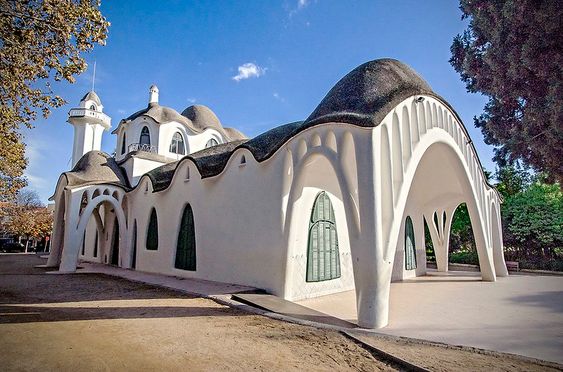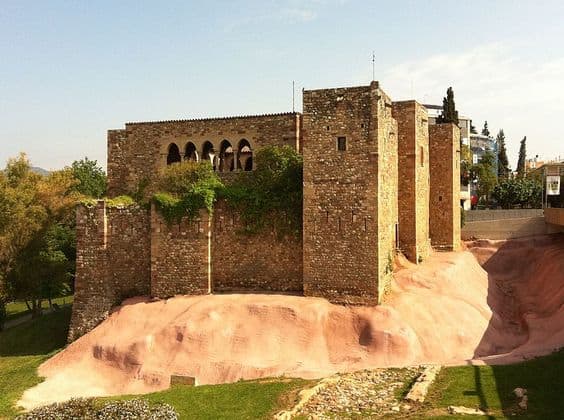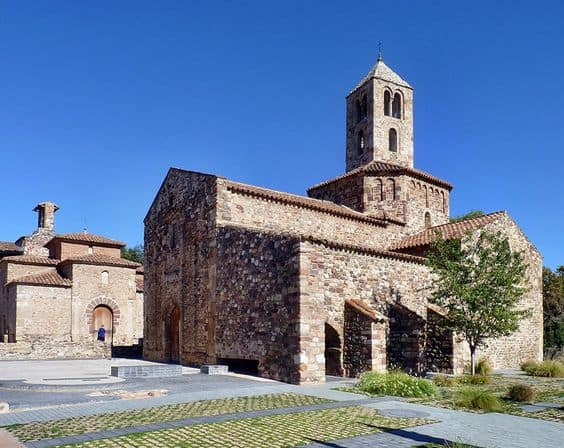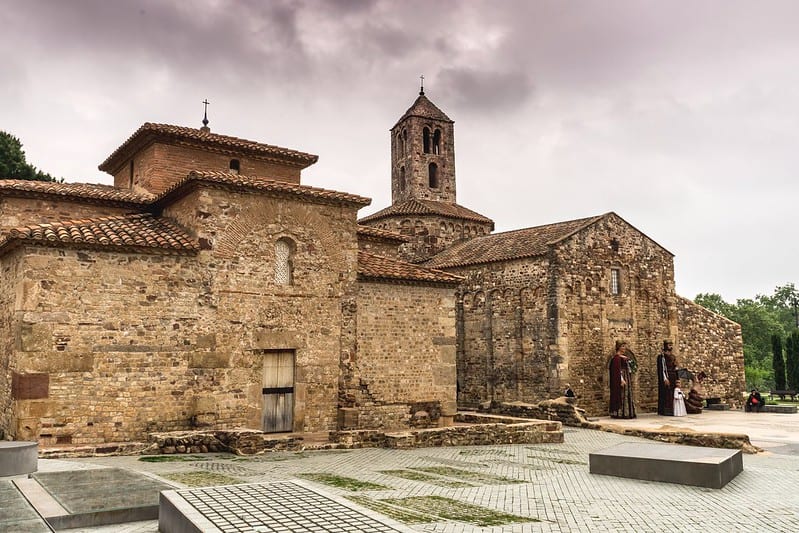This city in Catalonia is located in the province of Barcelona and the comarca of Vallès Occidental. It is co-capital with Sabadell. It has plenty to offer for visitors, from its museums to its medieval castle. If you’re not sure where to start, try exploring the city by foot.
In the Middle Ages, Terrassa was part of the County of Barcelona, which was a powerful political and economic entity in the region. In the early 18th century, the War of the Spanish Succession resulted in the annexation of Terrassa to the Kingdom of Spain. The Industrial Revolution of the 19th century brought significant economic growth to the city, and it became a major textile and manufacturing center.
During the 20th century, Terrassa underwent rapid industrialisation and urbanisation, and it is now a modern city with a population of over 220,000. The city has a rich cultural heritage and is home to several important museums and landmarks, including the Church of Sant Pere de Terrassa and the Cau Ferrat Museum, which was founded by the Catalan artist Santiago Rusiñol.
During the Spanish Civil War (1936-1939), Terrassa was a Republican stronghold, and there were many clashes between the Republican forces and the Nationalists, who were led by General Francisco Franco. The city was heavily bombed by the Nationalists, and there was significant damage to infrastructure and buildings. Many residents of Terrassa supported the Republican cause, and there were numerous volunteer battalions from the city that fought against the Nationalists. After the Nationalists emerged victorious in the war, there was a period of repression in Terrassa and other parts of Catalonia, as Franco’s regime sought to suppress any remnants of Catalan nationalism or opposition to its rule.
History of Terrassa Spain
Nestled in the Catalonia region of Spain, Terrassa is a city with a fascinating history that dates back thousands of years. From its ancient origins to its modern-day prominence as an industrial and cultural hub, Terrassa’s journey through time is a captivating tale of evolution and resilience. Let’s take a historical voyage through Terrassa’s past with a timeline of significant events.
Prehistory and Roman Era:
- 2nd Century BC: Terrassa’s history can be traced back to the Iberian settlement of Egara, which existed in the area during the Roman Republic’s time.
- 1st Century BC: The Romans conquered the Iberian settlement and established a Roman city named Egara Forum. Roman influence brought urban development and infrastructure to the area.
Medieval Times:
- 5th Century: With the fall of the Western Roman Empire, the Visigoths established their rule in the region, leading to the decline of the Roman city.
- 713 AD: The Moors invaded the Iberian Peninsula, and the area that is now Terrassa came under Muslim rule.
- 801 AD: Charlemagne’s troops reclaimed the region, bringing it under the Carolingian Empire.
Middle Ages:
- 11th Century: Terrassa became a feudal territory under the control of various noble families.
- 12th Century: The Christian Reconquista reached Terrassa, and it was captured by the Catalan Count Ramon Berenguer IV.
Modern Era:
- 14th Century: The city’s economy thrived, with the growth of agriculture, textile production, and trade.
- 1721: Terrassa was granted the title of “Free Royal City” by King Philip V, acknowledging its autonomy and privileges.
- 19th Century: The industrial revolution transformed Terrassa into an important textile manufacturing centre, earning it the nickname “Catalan Manchester.”
20th Century:
- 1936 – 1939: Terrassa witnessed significant political upheaval during the Spanish Civil War, with battles and violence affecting the city.
- 1950s – 1970s: The city experienced rapid urbanization and growth due to industrialisation and an influx of migrants from other parts of Spain.
21st Century:
- 2006: Terrassa was designated as a UNESCO Creative City in the field of music, highlighting its vibrant cultural scene.
- 2020: The city continues to thrive as a major economic and cultural center in Catalonia, celebrating its historical heritage while embracing modernity.
Terrassa’s illustrious history is evident in its architecture, cultural traditions, and urban landscape. As a city that has stood the test of time, it proudly preserves its historical legacy while embracing the future with open arms. Whether exploring its ancient ruins, admiring its medieval buildings, or reveling in its contemporary offerings, Terrassa offers a unique and enriching experience that reflects the spirit of Catalonia’s captivating past.
How to get from Barcelona to Terrassa by bus and train
There are several options for traveling by train from Barcelona to Terrassa:
- The most convenient option is to take the Renfe Cercanías (Regional Railways) train from Barcelona Sants station to Terrassa. This train runs frequently and takes about 30 minutes to reach Terrassa. Tickets can be purchased at the station or online.
- Alternatively, you can take the Rodalies de Catalunya (Commuter Rail) train from Barcelona Sants or other stations in the city, such as Passeig de Gràcia or Clot-Aragó, to Terrassa. These trains also run frequently and take about 30-40 minutes to reach Terrassa. Tickets can be purchased at the station or online.
- If you prefer to travel by bus, you can take the SARFA bus from Barcelona Nord Bus Station to Terrassa. This journey takes about an hour, depending on traffic. Tickets can be purchased at the station or online.
It is recommended to check the schedules and routes in advance to plan your trip and ensure that you have a valid ticket before boarding the train or bus.
Masia Freixa
La Masia Freixa in Terrasse was designed by the architect Llus Muncunill. This imposing building is one of the best examples of Spanish modernism. It was erected in 1926 and is an iconic landmark of the area. The architect drew many inspirations from nature and medieval architecture to create a contemporary building that would evoke the spirit of the region.
The Masia Freixa is an example of modernist architecture and can be found in the Parc de Sant Jordi. The building was originally built as a textile factory, but was later converted into the family home of the industrialist Josep Freixa. The architect, Lluis Muncunill, used a parabolic arch to create a distinctive structure that is both functional and aesthetically pleasing. It is home to a large hall and a lobby, as well as a beautiful outdoor porch. It is available for a variety of functions including weddings, conferences, exhibitions, weddings, and events.
The cityscape of Terrassa consists of buildings of many styles and eras. This city used to be an industrial hub, and it has many historical buildings that bear testimony to its past. Among its notable landmarks are the Nordbahnhof (from 1899) and the textile museum.

Museu Nacional de la Ciència i la Tècnica de Catal
One of the three national museums in Catalonia, the National Museum of Science and Industry of Catalonia can be found in Terrassa, just outside of Barcelona. The museum’s exhibitions showcase everything from the history of Catalan wine to the technology that powers our modern world.
The MNACTEC is housed in an impressive modernist building in the town of Terrassa. Its exhibits cover a wide range of industrial history, with many exhibits easily accessible for all ages. The museum’s textiles exhibit, “La fabrica textil,” is a fascinating look into the process of making textiles.
The MNACTEC is one of three museums in Catalonia that are recognized by the parliament. There are also branches of this museum located in other cities.
Parc de Vallparadis
The Parc de Vallparadis in Terrasa is a large urban park on the edge of the Sant Llorenc del Munt Natural Park. This park is one of Catalonia’s largest and has a lot of cultural heritage. It has many interesting buildings that you can visit, such as the Textile Museum, the hospital of Sant Llatzer, and the new campus of Terrassa University.
The Vallparadis Park has water for boating, a public swimming pool, and fountains. There are also picnic areas and restaurants. It is also accessible for people with disabilities. It has elevators and ramps at several entrances. This park is also a good choice for families with children.
The Parc de Vallparadis is one of the city’s most prominent public spaces. It is a good example of how public spaces can be recovered. It was once a large-scale infrastructure that has been used as a public space. While it may not be as well-known as the Paris park, it has shown the potential for reorganisation and regeneration.
Carthusian of Vallparadís Castle
The old fortifications of the Carthusian of Vallparads were used by the family Berenguer until the 14th century, when they were sold to the Escaladei monks. However, in 1413, the community moved to Tiana, and the castle was then passed on to the Carmelitans of Santa Creus of Barcelona. It has undergone renovations since then and has been converted into a museum.
The artistic periods of Terrassa include Roman and Romanesque periods, as well as influences from Byzantine cultures. More recently, modernist artists have also contributed to the city’s culture. There are also archaeological discoveries in the Vallparads Charterhouse and park, which proves Palaeolithic and Neolithic life in the region.

Catedral de Terrassa
The Catedral de Terrassa in the town of Terrassa is a Gothic style cathedral. It was built between 1574 and 1616. The church had suffered several disasters, including a fire in the Civil War. During this time, the cathedral was used as a car park, but was restored in 1958. The restoration included a new bell tower, facade and attic.
The catedral of Terrassa is the town’s religious center, dedicated to the patron saint of Sant Esperit. It is a part of the city’s historical core. It was recently blessed on 8 November 2017, and is home to 850 urns.
The cathedral is one of Spain’s most beautiful buildings. It was built during the Middle Ages and was later turned into an episcopal city. It is also home to a retaule and Santissim capella.

Esglesies de Sant Pere
The Esglesies de Sant Pere de Terrassa are located at the confluence of the Montner and Vallparadis torrents. This ancient visigotic nucleus of the city is the site of the cathedral. The church and baptistery were restored by Josep Puig i Cadafalch.
The church has been a religious center for centuries and is a must-see attraction for those visiting the city. It is located in the northern recinte of the old Sant Pere district. The edifice has one nave and a single nau. It is dedicated to the saint Mary.
The Sant Pere church complex is a cultural landmark in Terrassa, Barcelona, Spain. It includes two churches – Sant Maria and Sant Miquel – and is located at the confluence of the Monner and Vallparadis rivers. Today, this area is the most important artistic quarter of the city. It features examples of Catalan Romanesque art. Previously, the complex was the location of the Diocese of Egara, which was a Visigoth nucleus.
The Conjunt Monumental is located on a high elevation between two torrents. Its three esgles are clearly formatted and the best times to visit the edifice are in segle VI, when it was enlarged and renovated.
Mercado de la Independencia
The Mercado de la Independenţă in Terrassa, Spain, has been around for over two centuries. The municipal government is looking into ways to modernize it and create more commercial space. This includes adding new technology and improving equipment. It will also include reconfiguring different commercial zones.
Located in the heart of Terrassa, this market is a tourist must-see. It occupies a triangular-shaped island with beautiful views of the Arrabal de Montserrat, the Rambla de Egara, and Carrer de la Goleta. It is a modernist building designed by Antoni Pascual i Carretero.
Casa Alegre De Sagrera
Casa Alegre De Sagrera in Terressa is a renovated 19th-century factory building. Once the headquarters of an important Terrassa manufacturer, this building is a fine example of the region’s industrial heritage and still features the original murals. The building underwent a major renovation in 1911, and now serves as a modernist style home.
The original house was constructed at the turn of the nineteenth century, and it underwent substantial renovations in 1911. It then became a model of bourgeois life in the middle of industrial Terrassa. In 1973, the house was turned into a museum, and original mural paintings are still visible in the first floor. It also houses the Salvans collection of oriental art, and the legacy of writers Agusti Bartra and Ferran Canyameres.
Despite the city’s industrial heritage, Terrassa was also a center for textile production in the past. Victor Balaguer once likened the city to Manchester. The Casa Alegre De Sagrera was purchased by the Terrassa municipality in 1973, and today it is part of the city’s Museum of Industrial Culture. The museum also includes the Cartoixa de Vallparadis and Seu d’Orgue.
Best Places to Eat in Terrassa Spain
Nestled in the heart of Catalonia, Terrassa is a city that delights the senses with its rich gastronomic offerings. From traditional Catalan dishes to innovative international flavors, the culinary scene in Terrassa is a true reflection of its diverse culture and history. Whether you are a food enthusiast or a curious traveler, here is a gastronomic journey through the best places to eat in Terrassa.
1. Can Parellada: A trip to Terrassa is incomplete without savoring the delectable Catalan cuisine at Can Parellada. This family-run restaurant offers authentic flavors in dishes like “Escalivada” (grilled vegetables), “Bacalao a la Llauna” (salted codfish), and the iconic “Crema Catalana” (Catalan custard).
2. La Mafia se Sienta a la Mesa: For lovers of Italian cuisine, La Mafia se Sienta a la Mesa is a must-visit. This charming Italian restaurant serves up an array of mouthwatering pastas, pizzas, and Italian specialties in a warm and welcoming ambiance.
3. Asador Pamplona: Meat enthusiasts will find heaven at Asador Pamplona. This steakhouse offers top-quality grilled meats, including succulent steaks and tender lamb, cooked to perfection and served with delectable sides.
4. Rincón Criollo: Experience the vibrant flavors of Argentina at Rincón Criollo, a delightful Argentine grill. The restaurant’s specialty, juicy grilled meats like “Choripán” (Argentine sausage sandwich) and “Parrillada” (mixed grill), will transport you to the heart of Buenos Aires.
5. Saona Restaurant & Café: A popular choice for locals and tourists alike, Saona Restaurant & Café offers a diverse menu featuring Mediterranean-inspired dishes, sandwiches, and salads. Don’t miss their mouthwatering burgers and flavorful tapas.
6. Oriental Grill: For lovers of Asian cuisine, Oriental Grill is a hidden gem in Terrassa. Indulge in a fusion of flavors with their sushi, sashimi, and delectable Asian-inspired dishes.
7. Bar Ca l’Esteve: Embrace the traditional Catalan tapas culture at Bar Ca l’Esteve. This charming tapas bar serves an array of small plates, perfect for sharing with friends and family, and creating a delightful tapeo experience.
8. Restaurante Mirch Masala: Treat your taste buds to the vibrant flavors of Indian cuisine at Restaurante Mirch Masala. From aromatic curries to tantalizing tandoori dishes, this restaurant will transport you to the streets of India.
9. Restaurante Índigo: Another excellent choice for Indian cuisine, Restaurante Índigo offers an extensive menu with a variety of flavors and spice levels. Don’t forget to try their flavorful biryanis and aromatic naans.
10. H3O Restaurant & Lounge Bar: This trendy restaurant and lounge bar offers a fusion of international and Mediterranean cuisines. With its stylish ambiance and creative dishes, H3O promises a memorable dining experience.
Embark on a culinary adventure through the flavors of Terrassa, where each dish tells a story of tradition, creativity, and passion. From the cozy tapas bars to the exquisite steakhouse, the best places to eat in Terrassa will undoubtedly leave you with a lasting impression and a desire to return for more culinary delights.
Best Places to Stay in Terrassa Spain
- DoubleTree by Hilton Hotel & Conference Center La Mola: This upscale hotel offers luxurious rooms, modern amenities, and a serene location surrounded by nature. It’s ideal for business travelers and those seeking a relaxing retreat.
- Terrassa Park Hotel: Situated near the city center, this stylish hotel provides comfortable rooms and a welcoming atmosphere. It’s a convenient choice for exploring Terrassa’s attractions and nearby areas.
- Hotel Don Candido: With its elegant décor and excellent facilities, Hotel Don Candido is a top choice for travelers looking for a touch of luxury. The hotel features a spa, outdoor pool, and spacious rooms.
- Hotel Vapor Gran: Housed in a former factory building, this boutique hotel combines history with modern comfort. It offers unique and well-designed rooms, making for a memorable stay.
- Hotel Terrassa Park: This budget-friendly hotel provides simple and clean rooms, making it an excellent choice for travelers on a budget. It’s conveniently located near public transport and dining options.
- Hostal del Carmen: Offering a more traditional accommodation experience, Hostal del Carmen provides cozy and affordable rooms in the heart of Terrassa.
- Catalonia Sabadell: Although not in Terrassa itself, this hotel is located in the nearby city of Sabadell and offers comfortable rooms and modern amenities. It’s a good option for those seeking slightly larger accommodation options.
10 interesting facts about Terrassa Spain
- Terrassa is a city located in the Catalonia region of Spain, about an hour’s drive from Barcelona.
- It has a population of over 220,000 people, making it the fifth-largest city in Catalonia.
- Terrassa has a rich history dating back to the Roman era, and its Old Town is home to many historic buildings and landmarks.
- The city is known for its textile industry, and it is home to the Textile Museum of Catalonia, which showcases the history and development of the textile industry in the region.
- Terrassa is also home to a number of cultural and artistic events, including the Terrassa Film Festival, which features independent and experimental films from around the world.
- The city has a number of parks and green spaces, including the Parc del Vallès, which is home to a variety of plant and animal species.
- Terrassa is located in the Penedès wine region, and it is known for its wine production and wine-related events, such as the Terrassa Wine Festival.
- The city is home to several sports teams, including FC Terrassa, a football club that plays in the Spanish third division.
- Terrassa is also home to a number of educational institutions, including the Universitat Politècnica de Catalunya and the University of Vic.
- The city is well-connected to the rest of Catalonia and Spain, with good transportation links by road, rail, and air. It is also located near several major airports, including Barcelona-El Prat Airport.

